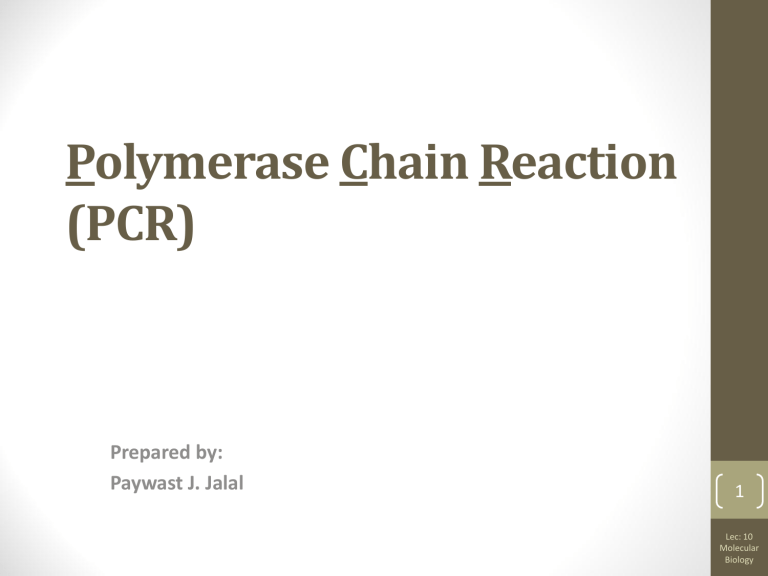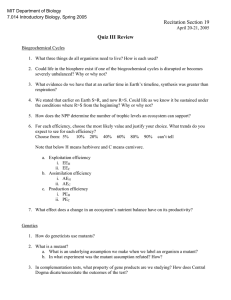
Polymerase Chain Reaction (PCR) Prepared by: Paywast J. Jalal 1 Lec: 10 Molecular Biology History of polymerase chain reaction (PCR) Definition and short technical overview of PCR Applications of PCR Practice the PCR Lec: 10 • • • • Molecular Biology Learning objectives 2 The Problem... There are a LOT of other sequences in a genome that we’re not interested in detecting. (SPECIFICITY) The amount of DNA in samples we’re interested in is VERY small. (AMPLIFICATION) Lec: 10 Two Big Problems: Molecular Biology How do we identify and detect a specific sequence in a genome? 3 Lec: 10 • Kary B. Mullis developed the polymerase chain reaction (PCR) in 1983. • The simple process involved heating a vial containing the DNA fragment to split the two strands of the DNA molecule, adding oligonucleotide primers to bring about reproduction, and finally using polymerase to replicate the DNA strands. Each cycle doubles the amount of DNA, so multiple cycles increase the amount of DNA exponentially, creating huge numbers of copies of the DNA fragment. • For his development of PCR, he was co-awarded the Nobel Prize in chemistry in 1993. Molecular Biology PCR History 4 Polymerase Chain Reaction (PCR) • PCR is a means to amplify a particular piece of DNA Lec: 10 • PCR can make billions of copies of a target sequence of DNA in a few hours • PCR was invented in the 1984 as a way to make numerous copies of DNA fragments in the laboratory • Its applications are vast and PCR is now an integral part of Molecular Biology Molecular Biology • Amplify= making numerous copies of a segment of DNA 5 DNA Replication vs. PCR • PCR is a laboratory version of DNA Replication in cells Lec: 10 • DNA replication is the copying of DNA • It typically takes a cell just a few hours to copy all of its DNA • DNA replication is semi-conservative (i.e. one strand of the DNA is used as the template for the growth of a new DNA strand) • This process occurs with very few errors (on average there is one error per 1 billion nucleotides copied) • More than a dozen enzymes and proteins participate in DNA replication …..DNA Polymerase, DNA Ligase, Primase, Helicase, Topoisomerase, Single strand binding protein Molecular Biology • The laboratory version is commonly called “in vitro” since it occurs in a test tube while “in vivo” signifies occurring in a living cell. 6 Lec: 10 1. Strands of template DNA (or RNA) are separated by melting 2. Forward Primer binds to one strand of template, Reverse Primer to other strand 3. DNA polymerase extends 3’ end of each primer, copying template 4. Strands are separated by raising temperature, allowing both original DNA and copies to act as templates 5. Repeat steps 2-4 many times Molecular Biology Basic Principles of PCR 7 The three main steps of PCR Step 2: Primers Anneal At 40C- 65C, the primers anneal (or bind to) their complementary sequences on the single strands of DNA Step 3: DNA polymerase Extends the DNA chain At 72C, DNA Polymerase extends the DNA chain by adding nucleotides to the 3’ ends of the primers. Lec: 10 Step 1: Denature DNA At 95C, the DNA is denatured (i.e. the two strands are separated) Molecular Biology • The basis of PCR is temperature changes and the effect that these temperature changes have on the DNA. • In a PCR reaction, the following series of steps is repeated 20-40 times (note: 25 cycles usually takes about 2 hours and amplifies the DNA fragment of interest 100,000 fold) 8 9 Lec: 10 Molecular Biology 37-65°C 70-75°C Lec: 10 94°C Molecular Biology The first round of PCR 10 Lec: 10 Molecular Biology PCR increases the yield of DNA exponentially 11 Lec: 10 Molecular Biology Exponential Amplification 30 cycles --- 1 billion copies in theory 12 Components of PCR Reaction Thermocyler Template DNA Flanking Primers dNTP (dATP, dTTP, dCTP, dGTP) Molecular Biology • • • • • building blocks for new DNA strands • PCR Buffer (mg++) Lec: 10 • PCR buffer provides optimal pH and salt condition • Thermo-stable polymerase • Taq Polymerase o DNA polymerase needs Mg++ as cofactor o Each DNA polymerase works best under optimal temperature, pH and salt concentration 13 Thermus aquaticus PCR Buffer • Basic Components (Stabilizes the DNA polymerase, DNA, and nucleotides) • Magnesium – Since Mg ions form complexes with dNTPs, primers and DNA templates, the optimal concentration of MgCl2 has to be selected for each experiment. Too few Mg2+ ions result in a low yield of PCR product, and too many increase the yield of non-specific products and promote misincorporation. • Potential Additives Molecular Biology • 20mM Tris-HCL pH 8.4 • 50mM KCl • 1.5 mM MgCl2 • • • • dimethyl sulphoxide (DMSO), dimethyl formamide (DMF), urea formamide • Long Targets >1kb. Formamide and glycerol • Low concentration of template: Polyethylene glycol (PEG) Lec: 10 • Helix Destabilisers - useful when target DNA is high G/C With NAs of high (G+C) content. 14 Why Are Primers Important? • Primers are what gives PCR its SPECIFICITY!!! • e.g. hairpins, homodimers, heterodimers Lec: 10 • Paired flanking primers • Length (18-30bp) for general applications (30-35 bp for multiplex PCR) • GC content 50-60% • GC clamp • Tm’s between 50-60°C • Avoid simple sequences – e.g. strings of G’s • Avoid primer self complementary Molecular Biology • Good primer design: PCR works great. • Bad primer design: PCR works terrible. 15 Factor 1: Melting / Annealing Temperature • Longer primers stick better = melt at a higher temperature. • GC CONTENT • More G-C content = more triple bonds = primers stick better = melt at higher temperature. • PCR Annealing Temp = Tm - 20°C Molecular Biology • PRIMER LENGTH Lec: 10 aagtcagtcagtactagtgatgta aagtcagtcag • Tm = [4(G + C) + 2(A + T)] °C 16 • Forward Primer (EcoR I ) T(a)= 56 5- ATT GGA ATT C AC ATC CGA CAC AAA TGT TG -3 • Reverse Primer (Hind III) T(a)= 56 5- AAA GGT TAA GCT TTA ATT AGT TCT CTT CGG A -3 Lec: 10 4381 gcggcgcgaa tgaacatctt attggctatc acatccgaca caaatgttgc catcccattg 4441 cttaatcgaa taaaaatcag gctacatggg tgctaaatct ttaacgataa cgccattgag 4501 gctggtcatg gcgctcataa atctggtata cttaccttta cacattgggg ctgattctgg 4561 attcgacggg atttgcgaaa cccaaggtgc atgccga ggg gcggttggcc tcgtaaaaag 4621 ccgcaaaaaa tagtcgcaaa cgacgaaaac tacgctttag cagcttaata acctgcttag 4681 agccctctct ccctagcctc cgctcttagg acggggatca agagaggtca aacccaaaag 4741 agatcgcgtg gaagccctgc ctggggttga agcgttaaaa cttaatcagg ctagtttgtt 4801 agtggcgtgt ccgtccgcag ctggcaagcg aatgtaaaga ctgactaagc atgtagtacc 4861 gaggatgtag gaatttcgga cgcgggttca actcccgcca gctccaccaa aattctccat 4921 cggtgattac cagagtcatc cgatgaagtc ctaagagccc gcacggcgca agccctgcgg 4981 gcttttttgt gccctcaatt tgtcccgcga agtccgaaga gaactaatta aatccgaacc 5041 ttttaggccc attgataggc ccaacgaaaa gctctattgt ttacgttggg cctaaacgca Molecular Biology A gene sequence of E. coli MG1655 strain from (NCBI) 17 Factor 2: Complementarity • Excessive similarity between primers, especially at the 3’ ends, leads to the formation of “primer dimers” • PRIMER-TARGET (GOOD) atcggactatcga tagcctgatagctatacttatggcca • Ideally should be 100% similar for maximal specificity. • Primers don’t HAVE to be perfectly similar to target to work. Molecular Biology gctatacttatggcca • PRIMER-PRIMER (BAD) Lec: 10 atcggactatcga 18 Some related terms Polymerases: enzymes that link individual nucleotides together to form long DNA or RNA chains Hybridisation (annealing:) the joining of two complementary DNA (or RNA) strands to form a double strand Lec: 10 Primer: a short DNA fragment with a defined sequence that serves as an extension point for polymerases Molecular Biology Sequence: the order of the nucleotides in DNA (DNA sequence) or RNA (RNA sequence) 19 Quick Reliable Sensitive Relatively easy Specific • • • • • • • Need for equipment Taq polymerase is expensive Contamination False reactions Internal control Cross-reaction Enrichment steps in (contaminated) samples • Capacity building needed • Unspecific amplification Molecular Biology • • • • • Disadvantage of PCR Lec: 10 Advantages of PCR 20 • • • • • Lec: 10 • • • Detection of specific genome Classical PCR - with a primer pair Colony PCR Nested PCR - amplification of larger area then specific detection in multiplied genome part (more sensitive) Multiplex PCR- Amplifying various genes simultaneously (uses more than one set of primers) Real time PCR - uses fluorescent markers to track the number of copies of target sequence produced in each cycle (to quantify the amount of genome in sample) Reverse Transcriptase PCR- Detection of RNA with reverse transcriptase enzyme Screening specific genes for unknown mutations Genotyping using short primers or primer pairs that are often repeated in the genome Molecular Biology Applications of PCR 21 Uses of PCR • Forensics: PCR’s ability to amplify even the smallest amount of DNA from samples collected at a crime scene gives the method great power when used in criminal forensics. • Paternity Testing By amplifying specific DNA fragments from parents or close relatives, it is possible to reconstruct relatedness between individuals. also PCR used to identify historical family relationships! • Archaeology Reconstructing the Dead Sea Scrolls. Identification of paint pigments in cave paintings. Determining relatedness between individuals in ancient ossuaries. Constructing dinosaurs from blood preserved in amber specimens. (!) Lec: 10 PCR can be used to accurately measure the exact quantity of geneticallymodified food in a shipment, by “looking” at the DNA that makes up the food! Molecular Biology • GMO Food Detection 22 Uses of PCR • Disease Diagnosis real-time PCR is used to directly monitor the amount of HIV virus in patients suffering from infection. By monitoring the amount of virus present, the drug therapy can be continually adjusted to maximize virus suppression. • Basic Research Quantitative PCR is a key component of determining the levels of gene expression, and is a critical tool in cancer research, disease studies, and developmental biology. Lec: 10 • Disease Treatment Molecular Biology PCR can identify disease-causing organisms much earlier than other methods, since it looks for the DNA of the organism itself, not its proteins or its effect on our immune system. PCR has even been used to diagnose diseases of the past, by amplifying minute amounts of disease-related DNA in preserved specimens. 23 Lec: 10 • Can You amplify RNA by PCR? • Do PCR reaction needs a source of energy? • What is the difference between amplification of genome invitro and invivo? Molecular Biology Questions? 24 Restriction Digestion Result Molecular Biology Group B Group C EcoRI HindIII SmaI EcoRI HindIII SmaI Lec: 10 1500bp Group A Ladder plasmid EcoRI HindIII Sma I 25



